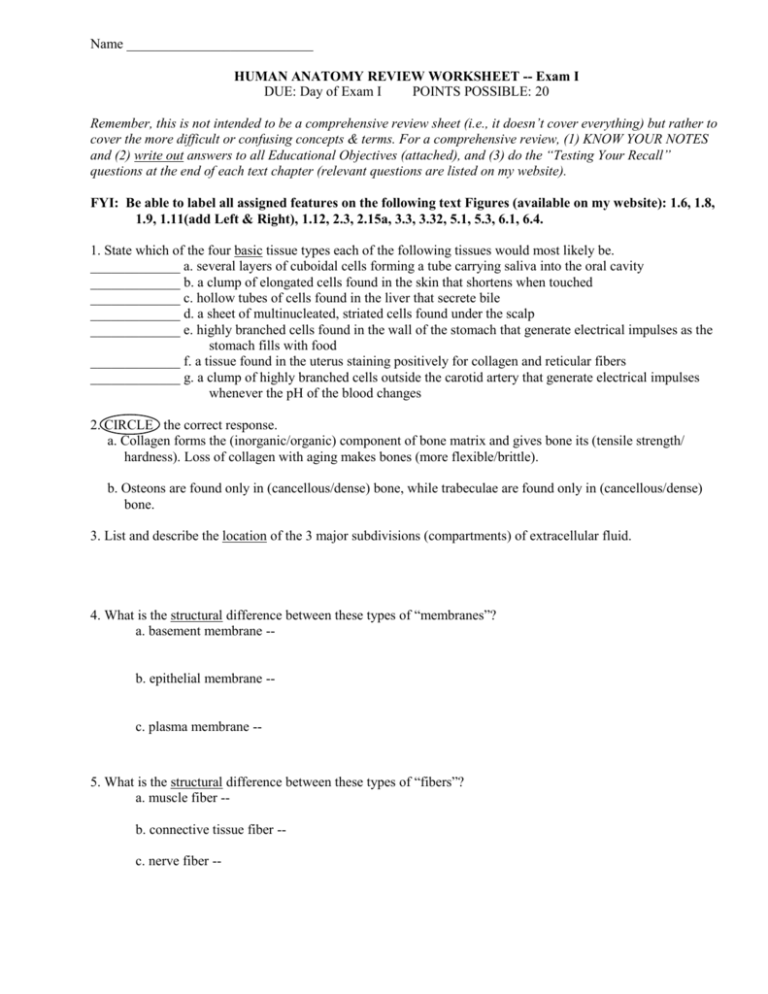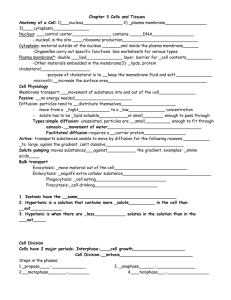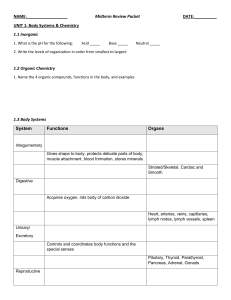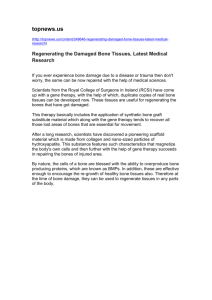HUMAN ANATOMY REVIEW WORKSHEET
advertisement

Name ___________________________ HUMAN ANATOMY REVIEW WORKSHEET -- Exam I DUE: Day of Exam I POINTS POSSIBLE: 20 Remember, this is not intended to be a comprehensive review sheet (i.e., it doesn’t cover everything) but rather to cover the more difficult or confusing concepts & terms. For a comprehensive review, (1) KNOW YOUR NOTES and (2) write out answers to all Educational Objectives (attached), and (3) do the “Testing Your Recall” questions at the end of each text chapter (relevant questions are listed on my website). FYI: Be able to label all assigned features on the following text Figures (available on my website): 1.6, 1.8, 1.9, 1.11(add Left & Right), 1.12, 2.3, 2.15a, 3.3, 3.32, 5.1, 5.3, 6.1, 6.4. 1. State which of the four basic tissue types each of the following tissues would most likely be. _____________ a. several layers of cuboidal cells forming a tube carrying saliva into the oral cavity _____________ b. a clump of elongated cells found in the skin that shortens when touched _____________ c. hollow tubes of cells found in the liver that secrete bile _____________ d. a sheet of multinucleated, striated cells found under the scalp _____________ e. highly branched cells found in the wall of the stomach that generate electrical impulses as the stomach fills with food _____________ f. a tissue found in the uterus staining positively for collagen and reticular fibers _____________ g. a clump of highly branched cells outside the carotid artery that generate electrical impulses whenever the pH of the blood changes 2. CIRCLE the correct response. a. Collagen forms the (inorganic/organic) component of bone matrix and gives bone its (tensile strength/ hardness). Loss of collagen with aging makes bones (more flexible/brittle). b. Osteons are found only in (cancellous/dense) bone, while trabeculae are found only in (cancellous/dense) bone. 3. List and describe the location of the 3 major subdivisions (compartments) of extracellular fluid. 4. What is the structural difference between these types of “membranes”? a. basement membrane -- b. epithelial membrane -- c. plasma membrane -- 5. What is the structural difference between these types of “fibers”? a. muscle fiber -b. connective tissue fiber -c. nerve fiber -- 6. Give another name for these terms and features. a. b. c. d. e. transverse planemidsagittal planefrontal planehypogastric abdominal regionperforating canal- f. osteong. central canalh. merocrine sweat gland- 7. List four structural/histological differences between thick skin and thin skin. 8. Chondroblasts are involved in (intramembranous/endochondral) ossification. In a teenager, chondroblasts are involved in (interstitial/appositional) growth. 9. List the tissues or organs in which you would find the following. a. keratinocyte -d. neuroglia -b. dendrites -e. intercalated discs -c. chondrocytes-f. osteoclast -10. List the five zones of the metaphysis, from epiphysis to diaphysis. 11. Complete this chart, comparing and contrasting the two types of sudoriferous glands. Feature Apocrine sweat gland Merocrine (eccrine) sweat gland Function Body-wide location & relative number of each Structure: lumen size & location of duct 12. Give meanings for the following word parts. (FYI List & define a term that uses each of these word parts) pathohypointerreticpoiepseudointrapapilla -tomy caudendosubcardioquadcutacytlyssectdermhemogenplexperisquamhyperstratparachondrosoma striatexopili sudorepiosteodendrolamella glia a-blast lamina cerummyohisto-ology extramorphgastrmelanmicro-clast FYI Anatomy Educational Objectives (If you really want a thorough review, you should be able to write out complete “answers” to all these objectives.) A Note on Terminology Building an anatomical/physiological vocabulary is essential for success in both courses and your career. For each unit/system, be able to define and use each assigned word root. For all units Label all assigned features on all assigned Figures (available on my website). I. Body as a Whole 1. List the levels of structural organization in the human body from least complex to most complex. 2. Define and give an example of each level of structural organization in the human body. 3. Describe and give examples of the relationships between structure and function at each level of organization. 4. Define anatomy and its subdisciplines. 5. Define the assigned word roots used to construct anatomical terminology. (This objective is to be met in all subsequent topics.) 6. List and give examples of the three parts of a typical medical term. 7. State why medical terms are preferred over eponyms. 8. Define the anatomical position. 9. Give the anatomical terms for assigned body regions. 10. Define all assigned directional terms and use each correctly in a sentence. 11. Define and identify examples of anatomical planes and sections. 12. List and identify the major body cavities and their general contents. 13. Sketch and label the abdominopelvic quadrants and regions. II. Cells 1. List the 3 major structural components of the human body. 2. List the 2 major compartments of body fluids. 3. List the 3 major subdivisions of extracellular fluid and their location. 4. List and sketch 9 types of cell shapes. 5. List 4 major structural components of a cell and the major functions of each component. 6. List 3 types of cell extensions and the function of each. 7. Describe, recognize, and give functions for assigned cell organelles. 8. Explain why the cell is considered the body’s unit of structure and function. 9. Describe the fluid-mosaic model of the plasma membrane. III. Tissues 1. List the four basic tissue types. 2. Sketch an example of how a 3-D structure looks in a 2-D microscopic view. 3. Describe the general structural features and functions of epithelial tissues. 4. Differentiate the two types of glandular epithelium. 5. Describe the criteria used to classify covering and lining epithelia. 6. Give a description, location and function for simple squamous epithelium. 7. Describe the general structural features and functions of connective tissues. 8. Give a description, location and function for areolar connective tissue. 9. Describe the locations and structure of three types of epithelial membranes. 10. Describe the locations of the three types of serous membranes. 11. Describe the general structural features and functions of muscle tissues. 12. Give specific structural descriptions, locations and functions for the three types of muscle tissue. 13. List the two main cell types of nervous tissue. 14. Sketch and label the 3 major parts of a neuron. 15. Describe the two major tissue types and two fiber types found in a neuromuscular junction. IV. Integumentary System 1. List the organs comprising the integumentary system. 2. List 5 functions of the integumentary system. 3. Describe the structure of the epidermis, including its layers and cell types. 4. Compare and contrast thick skin with thin skin, including structure, function, & location. 5. Describe the structure of the dermis. 6. Describe the structure of the following accessory organs of the integumentary system: subcutaneous layer, hair (with piloerector muscle), nails, merocrine (eccrine) and apocrine glands, sebaceous glands. 7. Compare the location and functional purpose of the two dermal capillary networks. 8. List the three pigments primarily responsible for skin color. 9. List and define 6 terms relating the color of skin to its diagnostic value. V. Skeletal System – Bone tissue 1. List 3 major components of the skeletal system. 2. List 5 functions of the skeletal system. 3. Sketch and label the features of a typical long bone. 4. Describe the blood and nerve supply to a typical long bone. 5. Name and describe the cell types involved in bone formation and remodeling. 6. List the components (and percentage of each) of bone matrix. 7. Sketch, label, and describe the histology of compact and spongy bone, including the location of each type. 8. Describe and sketch the processes of intramembranous and endochondral ossification in detail. 9. Describe and sketch the zones of an epiphyseal plate. 10. Compare and contrast the processes of interstitial and appositional growth. 11. Explain the process and purpose of bone remodeling. 12. Describe the causes, consequences, and prevention of osteoporosis. Examples of some integrative objectives 1. Describe the structural differences between a plasma membrane, a basement membrane, and an epithelial membrane. 2. Describe the structural differences between a muscle fiber, a connective tissue fiber, and a nerve fiber. 3. List and define 3 examples of the use of the word “interstitial” in this unit. Recall and apply all “deeper insights” assigned for this unit.







